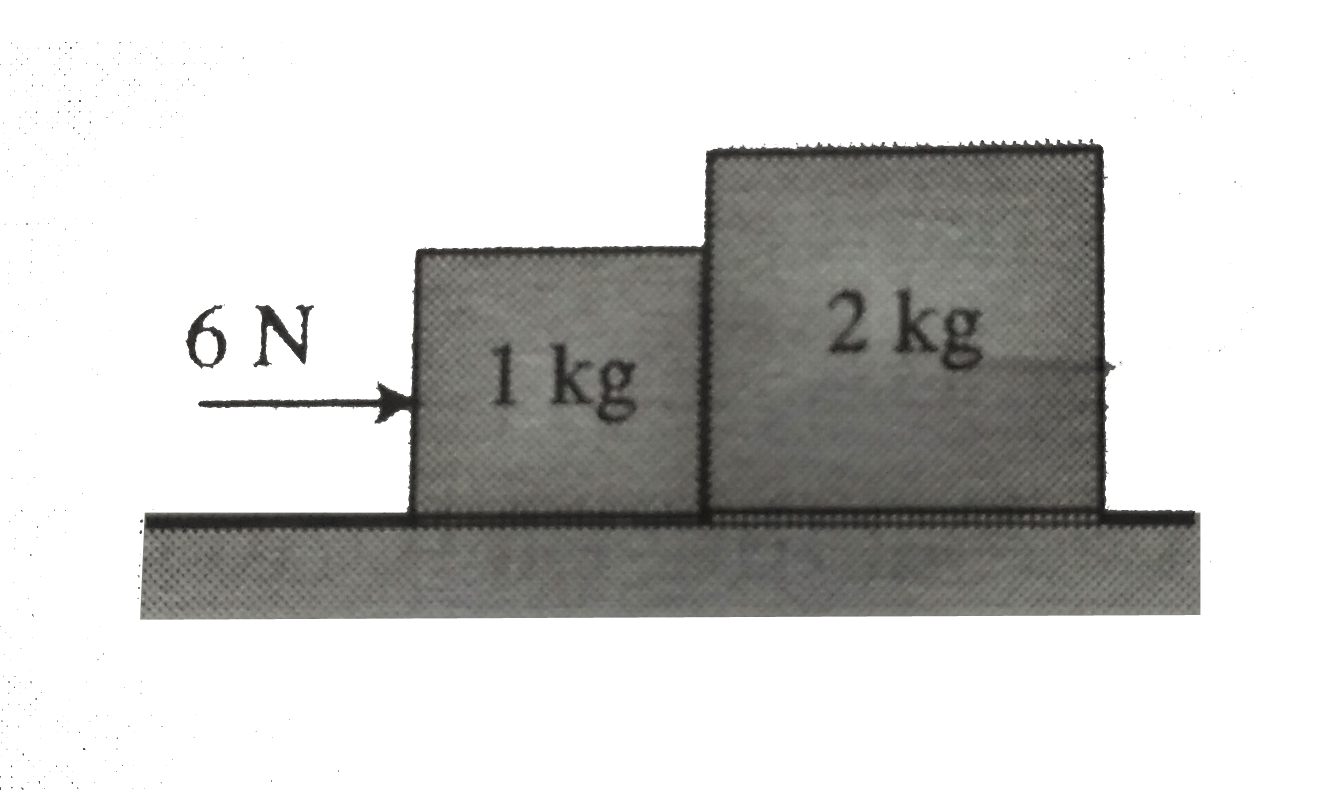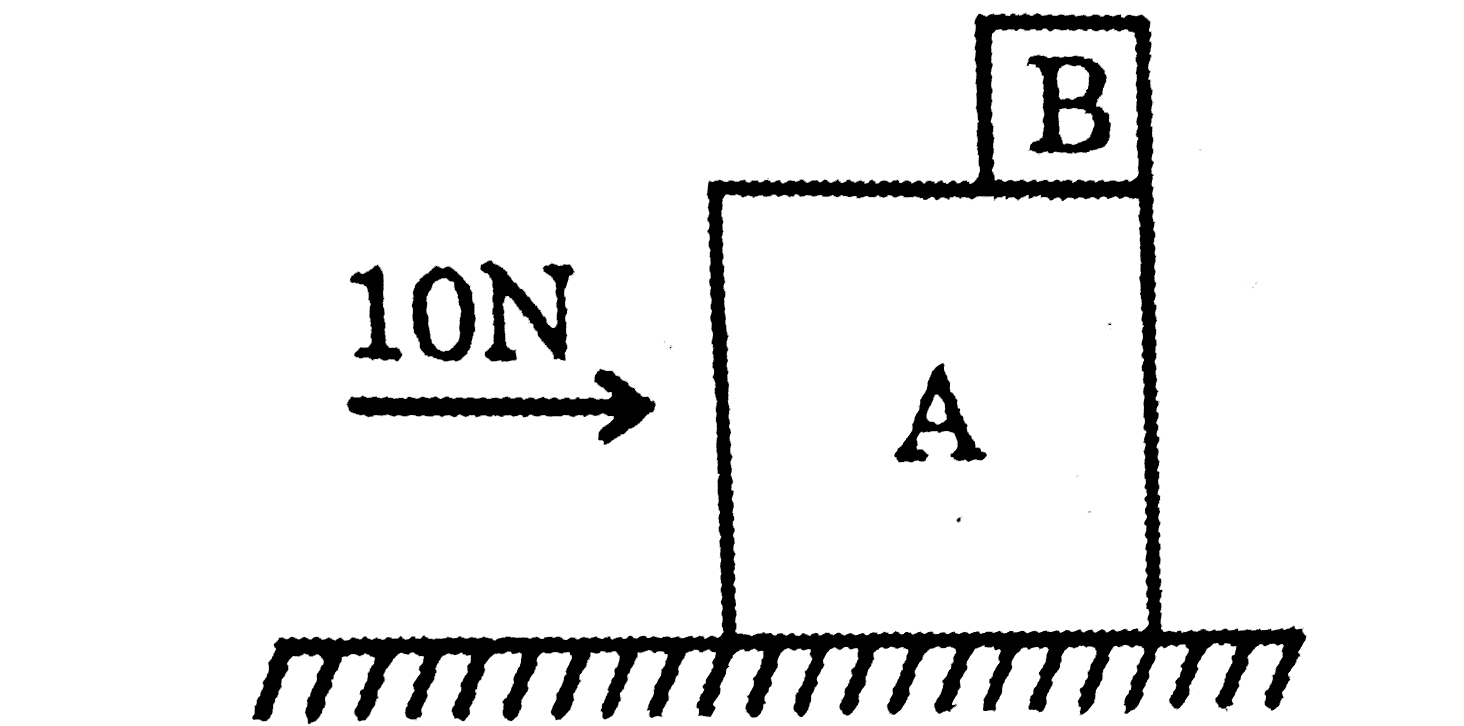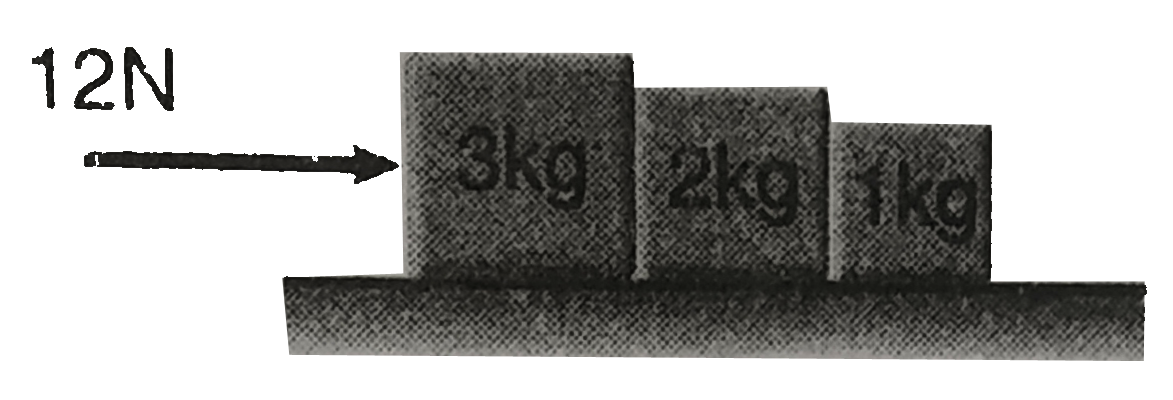A block of mass 50 kg is kept on another block of mass 1 kg as shown in figure. A horizontal force of 10 N is applied on the 50kg block. (All surface are smooth). Find
(g=10m/s2)
Acceleration of block A and B.
The correct Answer is:0.2m/s2, 0
To solve the problem, we need to analyze the forces acting on both blocks and apply Newton's laws of motion.
Given:
- Mass of block A (m1) = 50 kg
- Mass of block B (m2) = 1 kg
- Horizontal force (F) applied on block A = 10 N
- Acceleration due to gravity (g) = 10 m/s²
Step 1: Identify the forces acting on block A (50 kg)
The only horizontal force acting on block A is the applied force of 10 N. Since the surface is smooth (frictionless), the only force acting in the vertical direction is the gravitational force (weight) and the normal force from block B.
Weight of block A (W1):
W1=m1⋅g=50kg⋅10m/s2=500N
Step 2: Identify the forces acting on block B (1 kg)
Block B only experiences the normal force from block A (N2) and its own weight.
Weight of block B (W2):
W2=m2⋅g=1kg⋅10m/s2=10N
Step 3: Apply Newton's second law to block A
For block A, we can write the equation of motion in the horizontal direction:
F=m1⋅aA
Where aA is the acceleration of block A.
Substituting the values:
10N=50kg⋅aA
Step 4: Solve for acceleration of block A
Rearranging the equation gives:
aA=10N50kg=0.2m/s2
Step 5: Apply Newton's second law to block B
Since block B is resting on block A and there is no horizontal force acting on it (due to the smooth surface), the acceleration of block B will be the same as that of block A.
Thus,
aB=aA=0.2m/s2
Final Results:
- Acceleration of block A (50 kg) = 0.2 m/s²
- Acceleration of block B (1 kg) = 0.2 m/s²
- Mass of block A (m1) = 50 kg
- Mass of block B (m2) = 1 kg
- Horizontal force (F) applied on block A = 10 N
- Acceleration due to gravity (g) = 10 m/s²
The only horizontal force acting on block A is the applied force of 10 N. Since the surface is smooth (frictionless), the only force acting in the vertical direction is the gravitational force (weight) and the normal force from block B.
W1=m1⋅g=50kg⋅10m/s2=500N
Block B only experiences the normal force from block A (N2) and its own weight.
W2=m2⋅g=1kg⋅10m/s2=10N
For block A, we can write the equation of motion in the horizontal direction:
F=m1⋅aA
Where aA is the acceleration of block A.
10N=50kg⋅aA
Rearranging the equation gives:
aA=10N50kg=0.2m/s2
Since block B is resting on block A and there is no horizontal force acting on it (due to the smooth surface), the acceleration of block B will be the same as that of block A.
aB=aA=0.2m/s2
- Acceleration of block A (50 kg) = 0.2 m/s²
- Acceleration of block B (1 kg) = 0.2 m/s²
Topper's Solved these Questions
- NEWTON'S LAWS OF MOTION & FRICTION BOOK - MOTIONCHAPTER - NEWTON'S LAWS OF MOTION & FRICTION EXERCISE - Questions For Practice
25 Videos
- NEWTON'S LAWS OF MOTION & FRICTION BOOK - MOTIONCHAPTER - NEWTON'S LAWS OF MOTION & FRICTION EXERCISE - Exercise - 1 (SECTION-A:- String Constrained, Wedge Constrained, Newtons Law theory Question, Equillibrium Questions (Normal and Tension), Problems with Acceleration (F=ma), Wedge problems)
27 Videos
- NEWTON'S LAWS OF MOTION & FRICTION BOOK - MOTIONCHAPTER - NEWTON'S LAWS OF MOTION & FRICTION EXERCISE - Exercise - 3 Section-B
12 Videos
- MODERN PHYSICS -1BOOK - MOTIONCHAPTER - MODERN PHYSICS -1EXERCISE - EXERCISE-4 ( LEVEL- II)
39 Videos
- NLM & FRICTIONBOOK - MOTIONCHAPTER - NLM & FRICTIONEXERCISE - EXERCISE-4 ( LEVEL-II)
15 Videos
Similar Questions
A block of mass 50 kg is kept on another block of mass 1 kg as shown in figure. A horizontal force of 10 N is applied on the 1 kg block. (All surface are smooth). Find (g=10m/s2)

Acceleratin of block A and B.
View SolutionA block of mass 50 kg is kept on another block of mass 1 kg as shown in figure. A horizontal force of 10 N is applied on the 50kg block. (All surface are smooth). Find
(g=10m/s2)
Force exerted by B on A.
View Solution
Knowledge Check
Two blocks of masses 1 kg and 2 kg are placed in contact on a smooth horizontal surface as shown in fig. A horizontal force of 6N is applied on a 1-kg block. Find the force of interaction of the blocks.

A4NB5NC10NDnone
A block of mass 50 kg is kept on another block of mass 1 kg as shown in figure. A horizontal force of 10 N is applied on the 1 kg block. (All surface are smooth). Find (g=10m/s2)

Force exerted by B on A.
View SolutionA block of mass 10 kg is moving on a rough surface as shown in figure. The frictional force acting on block is :-

View SolutionTwo blocks of masses 4kg and 2kg are placed side on a smooth horizontal surface as shown in the figure. A horizontal force of 20N is applied on 4kgblock. Find
(a) the acceleration of each block.
(b) the normal reaction between two blocks.

View SolutionA block of mass 6 kg is kept on rough surface as shown in figure. Find acceleration and friction force acting on the block. (Take g=10m/s2)

View SolutionA small block B is placed on block A of mass 5kg and length 20 cm. Initially block B in near the right end of block A .A constant horizontal force of 10N is applied to the block A All surfaces are smooth . Find the time elapsed (in sec) before blocks B separates from A.

View SolutionFind the accelerations a1,a2,a3 of the three blocks shown in figure if a horizontal force of 10 N is applied on a. 2 kg block, b. 3 kg block, c. 7 kg block. Take g=10ms2.

View SolutionThree blocks of masses 3kg,2kg and 1kg are placed side by side on a smooth surface as shown in figure. A horizontal force of 12N is applied on 3kg block. Find the net force on 2kg block.

View Solution
